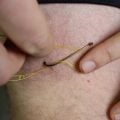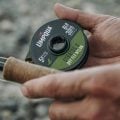How to Tie a Blood Dot Egg
Producer: tightlinevideo
Jeff Blood’s Blood Dot Egg was originally intended for use on Great Lakes lake-run rainbow trout, which are regionally called steelhead. In smaller sizes, however, many have found it to be extremely effective on smaller trout as well.
The fly starts with a size 14 scud/emerger hook. Get the hook firmly secured in the jaws of your tying vise.
The next step is to decide what color you want the egg and its blood dot, or yoke, to be. There are also different types of egg yarn to choose from. Here, I’m going to go with standard Egg Yarn from Wapsi in a pale yellow color. Measure out approximately a 5” long length and, using fairly large, very sharp scissors, snip the length free. Separate that length into two roughly equal halves, then separate into 2 each of those halves – so you’re left with 4 relatively equal 5” lengths. This will be enough to make a slew of Blood Dot Eggs.
To both conserve and keep track of the yarn segments, I like to twist one end of them up then secure that end using plunger-style hackle pliers. I’ll then snip a little bit of the end off square and set the segment aside so it’s ready for tie-in. Next I choose a contrasting color, here, one called “roe” for the yoke or blood dot, and repeat the same procedure for that color.
For thread, UTC 140 is a great choice and I’ll match my thread color to the lighter color of egg yarn that I’m using. Here I’ve chosen a cream color because it’s very close to the pale yellow colored yarn I’ve already selected. Get the thread started on the hook shank behind the eye and, after taking a dozen or so wraps rearward, snip off the excess tag. Take a few more rearward wraps so your tying thread hangs at about the hook point.
Pick up one of the segments of the lighter-colored yarn and remove it from the plunger-style hackle pliers. Give your bobbin a light counterclockwise spin, as if you’re looking down on it, so the first thread wrap will jump slightly rearward and catch the very butt end of the yarn. Continue taking nice, tight rearward thread wraps, doing your best to bind the material directly to the top of the hook shank.
Now, pick up your bodkin and use it to create a fold that extends to the back edge of the hook bend. Remove the bodkin and grip the fold in the fingertips of your left hand. Then, use a pinch wrap to anchor the fold to the top of the hook shank. Pull the forward-pointing yarn back and take a thread wrap around just the hook shank in front of it. Follow this with another single wrap over top of the yarn. Repeat the folding and tie-in procedure again, this time forming a slightly smaller loop than the first. Make sure both loops are centered on top of the hook shank.
Next, pick up the contrasting color of yarn for the yoke or blood dot. Anchor one end on top of the hook shank, at the location of your tying thread. Then pull the forward-pointing, lighter material back, take a wrap in front of it, a single wrap over top of the blood dot material, then one in front – just around the hook shank.
Use your bodkin to create a third yarn fold, with the lighter-colored material – just slightly shorter than the previous one. Using the same tie-down procedure as before, end with multiple thread wraps immediately behind the hook eye.
Pick up your whip finish tool, sweep all the forward-pointing material rearward and complete a 4 or 5 turn, back to front whip finish, seat the knot well and snip or cut your tying thread free.
Twist up the excess forward-pointing material then, using your plunger-style hackle pliers, get hold of the yarn down by the hook and snip it off close. This remaining material can be used to produce another Blood Dot Egg.
Now, do pretty much the same thing to cut off the darker blood dot material even with the loops that are in front of and in back of it. The resultant egg should look something about like this.
Get hold of your favorite head cement, here Sally Hansen Hard as Nails, and apply a liberal coat to the exposed thread wraps on the underside of the fly.
Since styrofoam cups have become a no-no in many states, I instead use a silicone tumbler to secure the fly while it dries. Using the rim of the cup ensures the adhesive won’t stick to anything else.
And that’s the finished Jeff Blood’s Blood Dot. They’re cheap and quick to tie, as well as remarkably effective. When submerged in water, the yarn takes on a wonderful and realistic translucent look.
How to Tie a Bleeding Prawn (Stormy Evening) Steelhead Fly
How to Tie a Blood Knot











